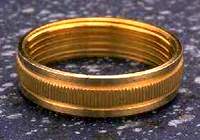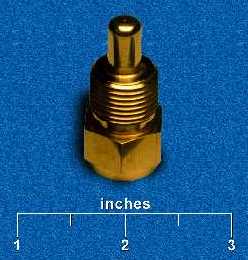CELLULAR ANTENNA BASE
| APPLICATION | Automotive Electronics |
| SPECIAL FEATURES | High Turnings Ratio |
| PART WEIGHT | 0.029 lb. (Brass) |
| BRASS RAW MATERIAL PREMIUM | 14% (Including Turnings Allowance) |
| CYCLE TIME (BRASS) | 3.7 sec (847 pieces per hour @ 80% Efficiency) |
| CYCLE TIME (LEADED STEEL) | 7.1 sec (355 pieces per hour @ 70% Efficiency) |
| PRODUCTIVITY GAIN USING BRASS | 138% |
| NET COST SAVINGS (BRASS VS. BARE STEEL) | 30% = $84.20 per 1000 |
| NET COST SAVINGS (BRASS VS.PLATED STEEL)* | 44% = $150.20 per 1000 |
BRASS COSTS LESS THAN STEEL
 This antenna base must be strong and corrosion resistant to work in the exterior environment that surrounds an automobile. It is made from Free-Cutting Brass, Copper Alloy 360, (UNS C36000), and costs about 44% less in brass than it would in 12L14 steel.
This antenna base must be strong and corrosion resistant to work in the exterior environment that surrounds an automobile. It is made from Free-Cutting Brass, Copper Alloy 360, (UNS C36000), and costs about 44% less in brass than it would in 12L14 steel.
Many designers think that because brass costs more than steel, machined brass parts must cost more too. That's not true for typical screw machine jobs. Only brass rod's off-the-shelf material cost is significantly higher. This part produces more than four times as much turnings weight as it does product, and after discounting for the turnings' high value, the net material savings is 14%.
HIGH MACHINABILITY MEANS LOWER PRODUCTION COSTS
When you buy machine parts you are paying for machine time. The faster the cut, the lower the cost, and free cutting brass machines faster than leaded steel. The productivity gain by switching from steel to brass for this part is an impressive 138%.
BRASS HAS GOOD MECHANICAL PROPERTIES
The strength of half-hard Free-Cutting Brass is in the same range as 12L14 steel. Published nominal values for these materials are:
| MATERIAL | TENSILE PROPERTIES | |
|---|---|---|
| YIELD STRENGTH | ULTIMATE STRENGTH | |
| C36000 | 45 ksi | 58 ksi |
| Hot Rolled 12L14 | 34 ksi | 57 ksi |
| Cold Drawn 12L14 | 60 ksi | 78 ksi |
The tensile strength of half-hard bras rod, the most common temper, is about 75% that of cold finished 12L14 steel. ELIMINATE PLATING COSTS Steel rusts, brass tarnishes; an important difference. Exposed steel parts have to be zinc/ chromate plated. Brass parts are ready to use without protective platings. The savings are between 11 and 16 cents per pound of product. If your part has deep holes, threads, or sharp corners, it can be difficult to insure uniform plating on all surfaces. Make the part in brass in you eliminate that concern. The natural corrosion resistance of brass uniformly protects the entire surface.
FITTING BODY
| APPLICATION | Underwater Pump Assembly |
| SPECIAL FEATURES | Teflon Coated |
| PART WEIGHT | 0.11 lb (Brass) |
| BRASS RAW MATERIAL PREMIUM | 23% (Including Turnings Allowance) |
| CYCLE TIME (BRASS) | 4.5 sec (641 pieces per hour @ 80% Efficiency) |
| CYCLE TIME (LEADED STEEL) | 8.0 sec (315 pieces per hour @ 70% Efficiency) |
| PRODUCTIVITY GAIN USING BRASS | 102% |
| NET COST SAVINGS (BRASS VS. BARE STEEL) | 22%, $35.17 per 1000 |
| NET COST SAVINGS (BRASS VS.PLATED STEEL)* | 3% = $6.87 per 1000 |
A CASE OF REVERSE ENGINEERING
 Sometimes materials selection decisions can be changed long after a part has been in production. That's the case with this fitting body, which forms part of an underwater pump assembly. It was made for many years using tellurium-treated leaded steel because its design required high machinability. One alert screw machine shop recognized that still higher machinability, and maybe some cost reductions, could be gained by switching from steel to Free-Cutting Brass, Copper Alloy 360 (UNS C36000). The screw machine shop brought a test run to the customer, the customer recognized the quality of the product, changed the specs to brass and gave the enterprising machine shop the order. Today, many hundreds of thousands of parts later, the fitting is still being made from brass.
Sometimes materials selection decisions can be changed long after a part has been in production. That's the case with this fitting body, which forms part of an underwater pump assembly. It was made for many years using tellurium-treated leaded steel because its design required high machinability. One alert screw machine shop recognized that still higher machinability, and maybe some cost reductions, could be gained by switching from steel to Free-Cutting Brass, Copper Alloy 360 (UNS C36000). The screw machine shop brought a test run to the customer, the customer recognized the quality of the product, changed the specs to brass and gave the enterprising machine shop the order. Today, many hundreds of thousands of parts later, the fitting is still being made from brass.
Brass can be cost-competitive with steel because its machinability is so much higher than steel's-about five times higher, in fact. And brass turnings are worth a lot of money; when recycled, they greatly reduce brass's net cost to the customer.
BRASS STRENGTH EQUIVALENT
Like most screw machine products, this pump part operates at stresses well within the limits of both brass and steel. In fact, brass and steel are often interchangeable because their strengths overlap the same range.
| MATERIAL | TENSILE PROPERTIES | |
|---|---|---|
| YIELD STRENGTH | ULTIMATE STRENGTH | |
| C36000 | 45 ksi | 58 ksi |
| Hot Rolled 12L14 | 34 ksi | 57 ksi |
| Cold Drawn 12L14 | 60 ksi | 78 ksi |
One more thing: this fitting body must be Teflon-coated, whether it's made from steel or brass. This presents no problem, as brass readily accepts most commercial coatings and finishes, TefIon included.
